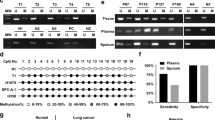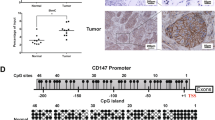Abstract
Bone morphogenetic protein 3B (BMP3B) is a member of the TGF-β superfamily. The BMP3B promoter sequence was previously identified as a target for aberrant DNA methylation in non-small-cell lung cancer (NSCLC). Aberrant DNA hypermethylation in the BMP3B promoter is associated with downregulation of BMP3B transcription in both primary human lung cancers as well as lung cancer cell lines. In order to understand the mechanisms of BMP3B silencing in lung cancer, a sample set of 91 primary NSCLCs was used to detect aberrant BMP3B promoter methylation, mutations in the coding sequence of BMP3B, and loss of heterozygosity (LOH). Our results showed that 45 of 91 (or 49.5%) tested primary NSCLCs exhibited increased promoter methylation, and 40% demonstrated LOH in at least one of the flanking microsatellite markers sJRH and D10S196 (63 kb upstream or 3.338 Mbp downstream of BMP3B). The lung cancer cell line A549, a type II alveolar epithelial human lung cancer cell line, is characterized by aberrant DNA promoter methylation. We used retroviral vector constructs containing the BMP3B cDNA to re-express the gene in A549 cells and to investigate the effects on cell growth. No change in the cell growth rate was observed after BMP3B re-expression, as compared to the vector controls. Although the number of colonies formed in anchorage-dependent assays was only slightly decreased, the colony-forming ability of A549 cells after BMP3B expression in anchorage-independent assays in soft agar was significantly reduced to 10% (P<0.005, t-test). Moreover, the in vivo tumorigenicity assay in nude mice indicated that cells re-expressing BMP3B grew significantly slower than cells not expressing BMP3B (P<0.05, t-test). In conclusion, this study provides evidence that BMP3B expression is repressed by different mechanisms in lung cancer, and that the silencing of BMP3B promotes lung tumor development.
This is a preview of subscription content, access via your institution
Access options
Subscribe to this journal
Receive 50 print issues and online access
$259.00 per year
only $5.18 per issue
Buy this article
- Purchase on Springer Link
- Instant access to full article PDF
Prices may be subject to local taxes which are calculated during checkout



Similar content being viewed by others
References
Akhurst RJ . (2002). J. Clin. Invest., 109, 1533–1536.
Baylin SB, Herman JG, Graff JR, Vertino PM and Issa JP . (1998). Adv. Cancer Res., 72, 141–196.
Caulin C, Scholl FG, Frontelo P, Gamallo C and Quintanilla M . (1995). Cell Growth Differ., 6, 1027–1035.
Colasante A, Mascetra N, Brunetti M, Lattanzio G, Diodoro M, Caltagirone S, Musiani P and Aiello FB . (1997). Am. J. Respir. Crit. Care Med., 156, 968–973.
Costello JF, Fruhwald MC, Smiraglia DJ, Rush LJ, Robertson GP, Gao X, Wright FA, Feramisco JD, Peltomaki P, Lang JC, Schuller DE, Yu L, Bloomfield CD, Caligiuri MA, Yates A, Nishikawa R, Su Huang H, Petrelli NJ, Zhang X, MS OD, Held WA, Cavenee WK and Plass C . (2000). Nat. Genet., 24, 132–138.
Dai Z, Lakshmanan RR, Zhu WG, Smiraglia DJ, Rush LJ, Fruhwald MC, Brena RM, Li B, Wright FA, Ross P, Otterson GA and Plass C . (2001). Neoplasia, 3, 314–323.
Dammann R, Li C, Yoon JH, Chin PL, Bates S and Pfeifer GP . (2000). Nat. Genet., 25, 315–319.
Datto MB, Li Y, Panus JF, Howe DJ, Xiong Y and Wang XF . (1995). Proc. Natl. Acad. Sci. USA, 92, 5545–5549.
Derynck R, Akhurst RJ and Balmain A . (2001). Nat. Genet., 29, 117–129.
Derynck R, Goeddel DV, Ullrich A, Gutterman JU, Williams RD, Bringman TS and Berger WH . (1987). Cancer Res., 47, 707–712.
Faucheux C, Ulysse F, Bareille R, Reddi AH and Amedee J . (1997). Biochem. Biophys. Res. Commun., 241, 787–793.
Girard L, Zochbauer-Muller S, Virmani AK, Gazdar AF and Minna JD . (2000). Cancer Res., 60, 4894–4906.
Hannon GJ and Beach D . (1994). Nature, 371, 257–261.
Herman JG, Graff JR, Myohanen S, Nelkin BD and Baylin SB . (1996). Proc. Natl. Acad. Sci. USA, 93, 9821–9826.
Hino J, Takao M, Takeshita N, Konno Y, Nishizawa T, Matsuo H and Kangawa K . (1996). Biochem. Biophys. Res. Commun., 223, 304–310.
Hubank M and Schatz DG . (1994). Nucleic Acids Res., 22, 5640–5648.
Keski-Oja J, Raghow R, Sawdey M, Loskutoff DJ, Postlethwaite AE, Kang AH and Moses HL . (1988). J. Biol. Chem., 263, 3111–3115.
Kiemer AK, Takeuchi K and Quinlan MP . (2001). Oncogene, 20, 6679–6688.
Lee WH, Morton RA, Epstein JI, Brooks JD, Campbell PA, Bova GS, Hsieh WS, Isaacs WB and Nelson WG . (1994). Proc. Natl. Acad. Sci. USA, 91, 11733–11737.
Liang G, Gonzalgo ML, Salem C and Jones PA . (2002). Methods, 27, 150–155.
Massague J, Blain SW and Lo RS . (2000). Cell, 103, 295–309.
Miyazono K, Kusanagi K and Inoue H . (2001). J. Cell Physiol., 187, 265–276.
Oft M, Peli J, Rudaz C, Schwarz H, Beug H and Reichmann E . (1996). Genes Dev., 10, 2462–2477.
Plass C and Soloway PD . (2002). Eur. J. Hum. Genet., 10, 6–16.
Ridley A . (2000). Nature, 406, 466–467.
Samuel W, Nagineni CN, Kutty RK, Parks WT, Gordon JS, Prouty SM, Hooks JJ and Wiggert B . (2002). J. Biol. Chem., 277, 59–66.
Sasaki H, Kobayashi Y, Nakashima Y, Moriyama S, Yukiue H, Kaji M, Kiriyama M, Fukai I, Yamakawa Y and Fujii Y . (2002). Jpn. J. Clin. Oncol., 32, 85–89.
Skonier J, Neubauer M, Madisen L, Bennett K, Plowman GD and Purchio AF . (1992). DNA Cell Biol., 11, 511–522.
Smiraglia DJ and Plass C . (2002). Oncogene, 21, 5414–5426.
Tang B, Bottinger EP, Jakowlew SB, Bagnall KM, Mariano J, Anver MR, Letterio JJ and Wakefield LM . (1998). Nat. Med., 4, 802–807.
Thiery JP . (2002). Nat. Rev. Cancer, 2, 442–454.
Toyota M, Ho C, Ahuja N, Jair KW, Li Q, Ohe-Toyota M, Baylin SB and Issa JP . (1999). Cancer Res., 59, 2307–2312.
Toyota M and Issa JP . (2002). Methods Mol. Biol., 200, 101–110.
Verrecchia F and Mauviel A . (2002). J. Invest. Dermatol., 118, 211–215.
Zhu WG, Dai Z, Ding H, Srinivasan K, Hall J, Duan W, Villalona-Calero MA, Plass C and Otterson GA . (2001a). Oncogene, 20, 7787–7796.
Zhu WG, Lakshmanan RR, Beal MD and Otterson GA . (2001b). Cancer Res., 61, 1327–1333.
Acknowledgements
We thank Michael Weinstein for help and discussions and Kristin Becknell for editorial assistance. This work was supported in part by Grants P30 CA16058, RO1 CA93548 and R01 DE13123 (CP). This work is also supported by a V-Foundation translational award to CP, a Leukemia and Lymphoma Society Scholar.
Author information
Authors and Affiliations
Corresponding author
Rights and permissions
About this article
Cite this article
Dai, Z., Popkie, A., Zhu, WG. et al. Bone morphogenetic protein 3B silencing in non-small-cell lung cancer. Oncogene 23, 3521–3529 (2004). https://doi.org/10.1038/sj.onc.1207441
Received:
Revised:
Accepted:
Published:
Issue Date:
DOI: https://doi.org/10.1038/sj.onc.1207441
Keywords
This article is cited by
-
The functional multipotency of transforming growth factor β signaling at the intersection of senescence and cancer
Cellular and Molecular Life Sciences (2022)
-
PGM5-AS1 impairs miR-587-mediated GDF10 inhibition and abrogates progression of prostate cancer
Journal of Translational Medicine (2021)
-
Survival of lung cancer patients is prolonged with higher regucalcin gene expression: suppressed proliferation of lung adenocarcinoma A549 cells in vitro
Molecular and Cellular Biochemistry (2017)
-
Lung Cancer Stem Cells: Insights into Characterization and Regulatory Mechanisms
Current Molecular Biology Reports (2017)
-
Runx2 mediates epigenetic silencing of the bone morphogenetic protein-3B (BMP-3B/GDF10) in lung cancer cells
Molecular Cancer (2012)



